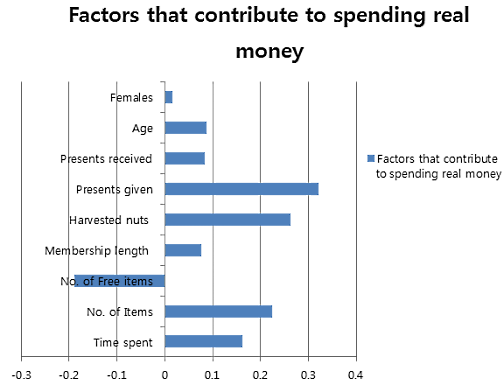Inside Social Games:游戏设计如何影响虚拟商品消费水平
(Donghee Yvette Wohn是密歇根州立大学的博士生候选人,以下是她关于社交游戏的研究报告。此外,Wohn还是一个研究游戏文化影响博客Play as Life的编辑。)
两年前,我曾经过参加一个讨论关于虚拟世界的会议。当时人们激烈谈论着微交易这种商业模式的可行性,很多人怀疑微交易在亚洲取得的成功并无法适用于北美用户。然而现在,人们不再谈论微交易是否产生效果,而更多的是研究如何使微交易产生效果。
对此,业内统计指出玩家的确愿意在社交游戏上花费一定的现实金钱。然而这类人在所有玩家中所占的比例很小。从研究的角度来看,我们很难发现这些付费用户的共同特点,因为我们无法在一个足够大的范例用户中归纳出这类人的共同特点。
为了获得一个更广泛的研究基础,我和日本庆应大学的同事与韩国社交游戏服务Puppy Red达成合作,手机为辨别的登录数据。我们研究的游戏类似于《企鹅俱乐部》,主要面向儿童和青少年。
我们收集了自2009年11月到2010年1月这3个月期间登录该网站多于一次的用户数据。在过滤了某些缺失或异常数据以后,该网站的用户总计有22万4827人,其中的6万4076名用户(占活跃用户的28.5%)曾不止一次使用现实货币,然而这一数据在最近3个月仅剩1万7750名,低于活跃用户的8%。
下图显示了该网站付费用户及其总计消费。从图中我们可以看出,在1万8000名用户中2000名用户的现金消费占全体用户现金消费的46%。
促进货币消费的因素
在促进货币消费的原因中,我们主要发现以下正面因素:游戏耗时,会员资格和道具总数。但其中就道具总数方面,我们的研究显示玩家获得越多免费道具,玩家花费的实际金钱就会越少。这一结果不同于某些市场调查显示的免费道具有利于促进玩家购买更多道具的观点。
礼物发放对消费的影响
此外,在我们的研究中更有趣的是那些关于“社交”元素的发现。比如,发放虚拟礼物和收到虚拟礼物可能会对玩家消费显示货币产生一定的积极影响。同时,玩家的朋友数虽然不会决定这位玩家是否会花费大量的现实金钱,但显然的是付费玩家比免费玩家拥有更多的朋友。这也就暗示我们,虽然朋友多并不一定会消费多,但玩家的朋友少那么消费就基本上多不了。
推论
最后,对于那些希望从微型交易中获利的公司,我们此次报告主要有以下提议:
1,提供多种用于装饰游戏空间或个人形象的虚拟商品,有利于刺激玩家消费。
2,限制免费发放的虚拟礼物数量。
3,鼓励玩家间多种形式的交换行为。此点针对游戏的社交机制有利于提高玩家的消费水平。
4,刺激玩家增加朋友数。朋友可以延长游戏时间,鼓励社交互动,创造竞争机制,从而刺激玩家的消费欲望。(本文为游戏邦/gamerboom.com编译)
[Donghee Yvette Wohn is a Ph.D. candidate at Michigan State University; her post, below, is based on research she is doing in social games. Wohn is also editor of Play as Life, a blog examining the cultural impacts of gaming.]
Only two years ago, I was attending a conference on virtual worlds and people were discussing whether or not microtransactions would be a viable business model. Many people were skeptical about whether the success of microtransactions in Asia would translate to North American users. Now, there seems to be less talk about whether or not microtransactions work, and more talk about what makes them work.
Industry stats show that yes, people are spending real money on social games. That said, however, the percentage of players who actually spend money is extremely small. From a research standpoint, it has been difficult to find out the characteristics of these spenders because of the difficulty in getting enough people to provide a sample size large enough to derive results that we could generalize.
To look at a larger population, my colleague at Keio University and I collaborated with Puppy Red, a social gaming service in South Korea, to collect de-identified log data. The game that we looked at was for children and tweens, similar to services like Club Penguin.
We collected the data of users who had accessed the site at least once during three months from November 2009 to January 2010. After conducting filtering process on missing data and outliers, the dataset showed 224,827 users. Among this population, 64,076 users (less than 28.5% of total active users) had spent real money at least once and only 17,750 (less than 8% of active users) had spent real money during the most recent three months.
The below graph shows the number of paying users and their cumulative spending. You can see that 2,000 of 18,000 users accounted for nearly half, 46 percent, of the total money people spent on the site.
Factors that contribute to spending real money
We looked at factors that contribute to spending real money, and found several positive predictors: time spent playing the game, length of membership, and overall number of items. However, players who had received more free items spent less real money. This point was interesting, because a lot of marketing research shows that free items are good for getting consumers to purchase more items. Our research suggests that too many free items can decrease the likelihood of spending.
Impact of Gifting on Spending
Perhaps our more interesting findings were those on “social” factors. For instance, giving virtual gifts and receiving virtual gifts were positively associated with the spending of real money. The number of friends did not determine whether one player who purchased virtual goods spent more money than another, but spenders did have significantly more friends than non-spenders. This implies that while more friends don’t lead to higher spending, players without a lot of friends may not spend any real money at all.
Implications
For those who want to cash in on microtransactions, our research suggests the following:
1. Provide a lot of virtual goods so that players can customize their game space and avatar.
2. Limit your amount of free virtual goods.
3. Encourage multiple types of exchange behavior between players; this is the second study we’ve done that implies that social players spend more
4. Incentivize having friends. Friends can increase playing time, encourage social interaction, and create competitive elements that contribute to spending. (Source:Inside Social Games)










































